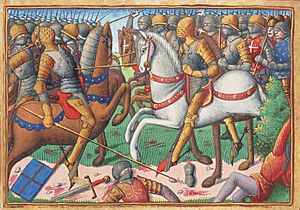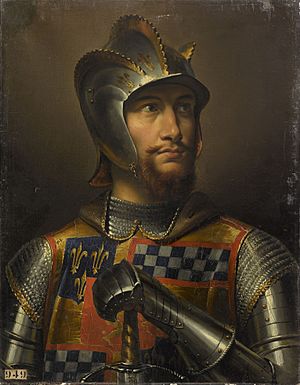Battle of Baugé facts for kids
Quick facts for kids Battle of Baugé |
|||||||
|---|---|---|---|---|---|---|---|
| Part of the Hundred Years' War | |||||||
 The Battle of Baugé, illustration from the manuscript of Martial d'Auvergne, Les Vigiles de Charles VII, c. 1484. |
|||||||
|
|||||||
| Belligerents | |||||||
| Commanders and leaders | |||||||
| Strength | |||||||
| 5,000 men | 4,000 men (although only 1,500 men directly took part in the battle) | ||||||
| Casualties and losses | |||||||
| very light | 1,000 dead 500 captured |
||||||
The Battle of Baugé was a big fight during the Hundred Years' War. It happened on March 22, 1421, in a place called Baugé in France. This battle was a major loss for the English army.
The English forces were led by Thomas, Duke of Clarence, who was the brother of the English King. On the other side, the French and Scottish armies fought together. They were led by John Stewart, Earl of Buchan, from Scotland, and Gilbert Motier de La Fayette, a French leader. The English had about 4,000 soldiers, but only 1,500 actually fought. The French and Scots had a larger army of about 5,000 men.
Contents
Why the Battle Happened
The Hundred Years' War Background
The Hundred Years' War was a long conflict between England and France. It lasted for over 100 years! In 1415, King Henry V of England wanted to restart the war. He sailed to France with a large army.
King Henry V won many battles, including the famous Battle of Agincourt. He took back many lands in France that England used to own.
Scotland Helps France
Scotland and France had a long-standing friendship and alliance called the Auld Alliance. This alliance started way back in 1295. By 1419, France was in a tough spot. The English had taken over an important region called Normandy. Also, the French capital, Paris, was controlled by another powerful group, the Burgundians.
France was also dealing with a civil war among its own people. Because of these problems, the French prince, known as the Dauphin, asked Scotland for help.
A Scottish army was formed. It was led by John Stewart, Earl of Buchan, and Archibald, Earl of Wigtown. From late 1419 to 1421, this Scottish army became very important. They helped the Dauphin defend the lower Loire valley in France.
English Raids and a Surprise Meeting
In 1421, King Henry V went back to England. He left his brother, Thomas, Duke of Clarence, in charge of the army in France. Following the King's orders, the Duke of Clarence led 4,000 soldiers on raids. They rode through the French regions of Anjou and Maine.
These raids, called a chevauchée (a military raid to destroy property), didn't face much resistance at first. By March 21, the English army set up camp near a small town called Vieil-Baugé.
Around the same time, the French and Scottish army of 5,000 men also arrived near Vieil-Baugé. Their goal was to stop the English. The French and Scottish army was led by the Earl of Buchan and the French Marshal, La Fayette.
The English forces were spread out. Many English archers had gone off to find food or loot. On March 21, one of these groups captured a Scottish soldier. This Scottish soldier told the Duke of Clarence about the large Scottish army.
Clarence wanted to fight right away. But there was a problem: the next day was Easter Sunday. This was a very holy day, and fighting on it was unthinkable. Waiting two days was also not an option for Clarence. So, according to old records, both sides agreed to a short break for Easter.
The Battle of Baugé
There are a few different stories about the Battle of Baugé. But most agree on one thing: the Duke of Clarence was too quick to act. He didn't realize how big the French and Scottish army really was. He decided to attack immediately, hoping to surprise them.
Clarence ignored the advice of his own leaders, like the Earl of Huntingdon. They told him to gather all his soldiers first. Instead, Clarence ordered the Earl of Salisbury to quickly bring all the archers to him.
Clarence then charged the French and Scottish lines with only about 1,500 soldiers. He had almost no archers with him. The Scots quickly got ready to fight. The battle began at a bridge that Clarence tried to cross. About 100 Scottish archers, led by Sir Robert Stewart of Ralston, held the bridge. They stopped the English long enough for the Earl of Buchan to gather the rest of his army.
When Clarence finally forced his way across the bridge, he faced the main French and Scottish army. Their soldiers were off their horses and well protected by Scottish archers. In the fierce close-quarters fighting, called a melée, John Carmichael of Douglasdale broke his spear, knocking the Duke of Clarence off his horse.
There are different stories about how Clarence died. One story says that a Scottish knight, Sir John Swinton, wounded him. But Alexander Buchanan is often given credit for killing the Duke with his mace. Buchanan then famously held the Duke's crown up on his spear to show their victory. Another story says a Highland Scot named Alexander Macausland killed Clarence. A French writer said a Frenchman killed him.
Later that day, probably in the evening, the Earl of Salisbury took action. He had managed to gather the English archers. He used some of them to rescue the remaining English soldiers. They also brought back the bodies of those who had fallen, including the Duke of Clarence.
What Happened Next
Scottish Victory and Rewards
The Scots allowed the rest of the English army, led by Salisbury, to escape. So, they missed a chance to completely remove the English from France. However, this battle made the Scottish army very famous in France.
When Pope Martin V heard about the Scottish victory, he repeated a common saying: "Truly the Scots are the cure for the English."
The French prince, the Dauphin, used this victory to his advantage. He announced that he would invade English-held Normandy. He rewarded the Scottish leaders. Archibald Douglas, Earl of Wigtown, was made the Count of Longueville. Sir John Stewart of Darnley received lands in France. The Earl of Buchan was made Constable of France, a very high military position.
In 1422, the Dauphin created a special group of 100 soldiers called the "Hundred Lances of France." These were added to the 24 archers of the Garde Ecossaise, a Scottish guard unit. The Hundred Lances later became the Gendarmerie of France, a famous military group. They fought bravely in battles like Fontenoy in 1745.
John Carmichael of Douglasdale became a bishop in 1426. He was one of six bishops at the coronation of the Dauphin as King Charles VII in 1429. This happened at Rheims Cathedral. Hugh Kennedy, a Scottish captain who fought with Joan of Arc, was given the right to add the French royal symbol, the fleur-de-lis, to his family's coat of arms.
Henry V's Return and Death
Meanwhile, King Henry V had been in England with his wife, Catherine of Valois. Catherine was crowned queen in February. Soon after, Henry and Catherine traveled separately around England.
While Henry was in northern England, he heard about the disaster at Baugé and his brother's death. People at the time said he took the news bravely. Henry then returned to France with a new army of 4,000 to 5,000 men. He arrived in Calais in June. He then went to Paris, which was controlled by the Burgundians, who were friendly with England.
Henry decided to capture some important southern towns that were still loyal to the French prince. He took the first town, then began to attack Meaux. This town was strongly fortified and held by the Dauphin's forces. The siege began in October and lasted seven months. The town finally fell on May 11, 1422. While fighting in France, Henry became ill and died on August 31, 1422. He likely died from dysentery.
The War Continues
England's war in France continued under the leadership of the Duke of Bedford. The English won several battles, including a big victory at the Battle of Verneuil in 1424.
At Baugé, Clarence had attacked without his archers. But at Verneuil, the English archers fought very effectively. This battle almost completely destroyed the French prince's main army. By this time, King James I had returned to Scotland. He was not keen on sending more help to the French. So, Scottish help for France became less important in the war.
However, the friendship between the Scots and French remained strong. Many Scots still joined the French army, especially as the fighting grew more intense. For example, when Joan of Arc marched into the city of Orléans after freeing it in 1429, many Scots who fought with her were heard playing the "March of Robert The Bruce." After Joan of Arc's death, the Scots renamed this march "The Hymn of Joan of Arc."
Today, on July 14, during France's national holiday (Bastille Day), many French military groups and Scottish pipe bands play this tune. It's a way to remember Saint Joan of Arc and to honor the Scots who helped free France from England.
Notable Casualties and Captives
English Deaths
- Thomas of Lancaster, 1st Duke of Clarence †
- John Grey, 1st Earl of Tankerville †
- John de Ros, 7th Baron de Ros †
- William de Ros †
- Gilbert V de Umfraville †
English Captives
- John Beaufort, Earl of Somerset captured by Laurence Vernon
- Thomas Beaufort, Duke of Exeter, captured by Tanneguy du Châtel.
- John Holland, Earl of Huntingdon captured by Sir John Sibbald of Balgonie
- Thomas Beaufort captured by Sir John Stewart of Darnley
- Walter FitzWalter, 7th Baron FitzWalter captured by Henry Cunningham
French Deaths
- Charles le Bouteiller
- Guérin de Fontaine
See also


